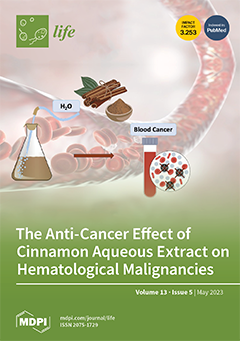In clinical practice, Alzheimer’s disease (AD), as one of the main neurodegenerative diseases globally, currently has no cure. Recently, the delaying and improving effects of physical exercise on AD have gradually been confirmed; however, the specific mechanism involved needs further clarification. (1) Objective:
[...] Read more.
In clinical practice, Alzheimer’s disease (AD), as one of the main neurodegenerative diseases globally, currently has no cure. Recently, the delaying and improving effects of physical exercise on AD have gradually been confirmed; however, the specific mechanism involved needs further clarification. (1) Objective: Explore the mechanism aerobic exercise plays in delaying AD by regulating mitochondrial proteostasis and provide new theoretical bases for improving and delaying AD through aerobic exercise in the future. (2) Methods: Male APP/PS1 mice were randomly divided into a normal group (NG, n = 20), activation group (AG, n = 20), and inhibition group (SG, n = 20). Then, the mice in each group were randomly divided into control group and exercise group (n = 10 mice each), yielding the normal control group (CNG), normal exercise group (ENG), active control group (CAG), active exercise group (EAG), inhibitive control group (CSG), and inhibitive exercise group (ESG). After adaptive training, the mice in the exercise groups were trained on an aerobic treadmill for 12 weeks; we conducted behavioral tests and sampled the results. Then, quantitative real-time PCR (Q-PCR) and Western blot analysis were performed. (3) Results: In the Morris water maze (MWM) test, the latency was significantly reduced and the number of platform crossings was significantly increased in the CAG and ENG compared with the CNG, while the result of the CSG was contrary to this. Compared with the ENG, latency was significantly reduced and the number of platform crossings was significantly increased in the EAG, while the opposite occurred for ESG. Compared with the CAG, the latency was significantly reduced and the number of platform crossings was significantly increased in the EAG, while the results for CSG were contrary. In the step-down test, compared with the CNG, the latency was significantly increased and the number of errors was significantly reduced in the CAG and ENG, respectively, while the results for CSG were contrary. Compared with the ENG, the latency was significantly increased and the number of errors was significantly reduced in the EAG, while the results for ESG were contrary. Compared with the CAG, the latency was significantly increased and the number of errors was significantly reduced in the EAG, while the results for CSG were contrary. Mitochondrial unfolded protein reactions (UPR
mt), mitochondrial autophagy, and mitochondrial protein import levels in each group of mice were detected using Q-PCR and Western blot experiments. Compared with the CNG, the UPR
mt and mitochondrial autophagy levels in the CAG and ENG were significantly increased and the mitochondrial protein import levels were significantly reduced, while the results for the CSG were contrary. Compared with the ENG, the UPR
mt and mitochondrial autophagy levels in the EAG were significantly increased and the mitochondrial protein import levels were significantly reduced, while the results for ESG were contrary. Compared with the CAG, the UPR
mt and mitochondrial autophagy levels in the EAG were significantly increased and the mitochondrial protein import levels were significantly reduced, while the results for CSG were contrary. (4) Conclusions: Aerobic exercise can improve cognitive function levels and delay the symptoms of AD in APP/PS1 mice by regulating mitochondrial proteostasis.
Full article






